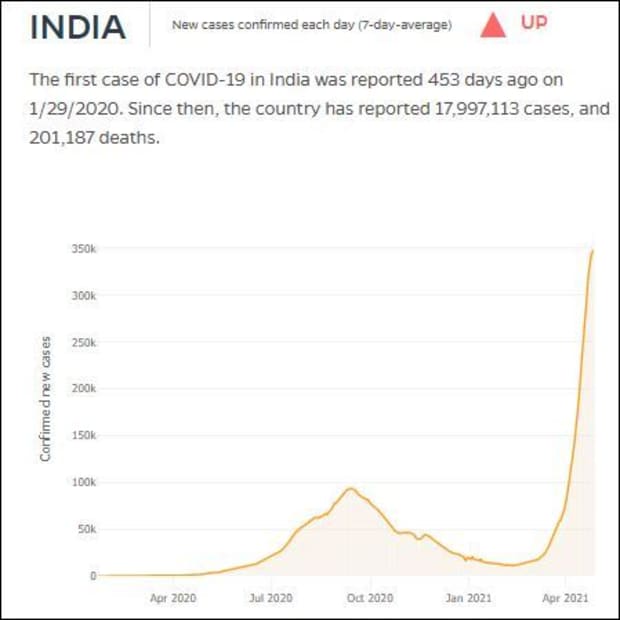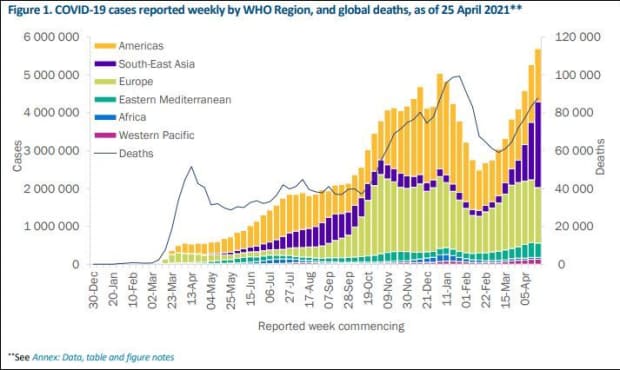This post was originally published on this site
Wealthy countries share blame for the COVID-19 crisis in India for failing to coordinate and create a global response to the coronavirus pandemic, and for hogging vaccine supply against the advice of health experts, Dr. Anthony Fauci said Wednesday.
Fauci, head of the National Institute of Allergy and Infectious Diseases and President Joe Biden’s chief medical adviser, told the Guardian Australia that the wave of infections currently overwhelming the Indian healthcare system has highlighted global inequality.
“The only way that you’re going to adequately respond to a global pandemic is by having a global response, and a global response means equity throughout the world,” Fauci said.
His comments echo those of leaders of the World Health Organization and United Nations, who have repeatedly called on the richer countries in the world not to snap up all vaccine supply, but to share it equally with poorer nations. Failure to do so is allowing new, more infectious variants to spread, and could lead to ones that prove resistant to the current vaccines that have won emergency use authorization around the world, they have warned.
India recorded another record of 360,960 COVID-19 cases on Wednesday, according to data from the health ministry, breaking the record it had set just days ago. The country of almost 1.4 billion people has suffered at least 200,000 deaths, a number widely held to be understated.

Source: Johns Hopkins University
Fauci said efforts by the WHO to get much-needed vaccines to India via its Covax program was not enough. “We have to do even more than that,” he told the newspaper.
“The United States has really revved up their activity in helping out India … we’re sending oxygen, remdesivir, personal protective equipment, a variety of other medications and soon we’ll be sending vaccine to help out,” he said.
He added that rich countries have a responsibility to help out, especially as Indians are dying because of a lack of medical oxygen and ICU beds. “Because we’re all in this together. It’s an interconnected world. And there are responsibilities that countries have to each other, particularly if you’re a wealthy country and you’re dealing with countries that don’t have the resources or capabilities that you have.”
The WHO said in its latest weekly epidemiological update that the “double-mutant” variant that is believed to be behind India’s current crisis has now been found in at least 17 countries. Called the B.1.617 strain, the new variant has two spike proteins instead of one.
But the co-founder of German biotech BioNTech SE said he is confident that the vaccine his company developed with Pfizer Inc. will work against the Indian variant.
“We are still testing the Indian variant, but the Indian variant has mutations that we have already tested for and which our vaccine works against, so I am confident,” Ugur Sahin told New Delhi Television.
“The vaccine is cleverly built and I’m convinced the bulwark will hold. And if we have to strengthen the bulwark again, then we will do it, that I’m not worried about,” he added.
The WHO update said global cases of COVID-19 rose for a ninth straight week in the seven-day period through April 25, with nearly 5.7 million new cases recorded. The number of deaths rose for a sixth straight week to more than 87,000.
Southeast Asia remains the hot spot with India accounting for the vast majority of new cases at 38% of the total.

Source: WHO
The U.S. vaccine program, meanwhile, continues to show good progress. The Centers for Disease Control and Prevention’s vaccine tracker is showing that as of 6.00 a.m. ET Tuesday, 297.5 million doses had been delivered to states, 232.4 million doses had been administered, and 141.8 million people had received at least one shot, equal to 42.7% of the population.
A full 96.7 million people are fully vaccinated, equal to 29.1% of the population, meaning they have received two shots of the two-dose vaccines developed by Pfizer Inc.
PFE,
and German partner BioNTech SE
BNTX,
and Moderna Inc.
MRNA,
or one shot of the Johnson & Johnson
JNJ,
one-shot vaccine. The AstraZeneca
AZN,
AZN,
vaccine has not been authorized for use in the U.S.
Among Americans 65 years-and -older, 37 million people are fully vaccinated, equal to 67.9% of that group. Almost 45 million people in that age bracket have received a first jab, covering 81.8% of that population.
In other news:
• The British Medical Journal published an open letter from trustees of the South Asian Health Foundation on Wednesday, calling on the Indian government to stop mass gatherings and postpone coming elections. “India invoked an exemplary lockdown during the initial wave of COVID-19 and it is perhaps now a time to consider whether the benefits of a lockdown outweigh the benefits of an immediate election,” said the letter. “Mass gatherings need to stop urgently. ” India’s current crisis is understood to have been greatly exacerbated by political rallies, at which thousands crowd together without wearing face masks, as well as a recent Hindu festival that saw thousands bathe in the river Ganges without wearing masks.
• President Biden said Tuesday that the experimental COVID-19 vaccine being developed by Novavax Inc.
NVAX,
may be nearing emergency-use authorization in the U.S., MarketWatch’s Jaimy Lee reported. “The problem is right now we have to make sure we have other vaccines like Novavax and others coming on,” he said during a speech. “And I think we’ll be in a position to be able to share vaccines with other countries who are in real need. That’s the hope and expectation.” Novavax’s still-investigational COVID-19 vaccine is currently being tested in a Phase 3 clinical trial in Mexico and the U.S. that began in December. A separate late-stage study in the U.K. is also under way, and early data from that trial found that the vaccine candidate had an overall efficacy rate of 89.7%.
• Brazil’s Senate has launched an inquiry into the federal government’s response to Covid-19, which could hobble President Jair Bolsonaro’s re-election bid if it leads to an impeachment proceeding or criminal charges, CNN reported. olsonaro has long downplayed the ferocity of the pandemic, while resisting lockdown measures and mask-wearing. While Covid-19 cases have started to plateau or decline in other countries, Brazil’s cases have continued to surge.
• Japan is planning to tighten border controls on travelers from Tennessee, Florida, Michigan and Minnesota, as well as India and Peru in response to the spread of new variants of the virus detected there, the Guardian reported. The new measure will come into effect on Saturday and require people coming from those places to quarantine in a designated facility and take a COVID-19 test on the third day after arrival, the paper reported, citing the Kyodo news agency.
• French President Emmanuel Macron will lift a ban on domestic travel starting next week, the Associated Press reported, while maintaining the current curfew from 7 p.m. to 6 a.m. The move comes after elementary schools reopened on Monday after three-week closure, even though the number of patients in ICU units remains high. Macron said he is anticipating a better situation next month when a greater proportion of the population will be vaccinated and the expected decrease in numbers of daily infections after the partial lockdown.
• U.S. companies turned to an old habit during the 2020 pandemic, according to a recent report from financial data provider Calcbench. Just a few years after a Securities and Exchange Commission crackdown on the overuse of nonstandard accounting metrics, companies in the S&P 500 resumed the practice in droves, the report found. Calcbench took a close look at S&P 500 companies’ use of both GAAP and non-GAAP numbers in 2020, with GAAP referring to Generally Accepted Accounting Principles, the U.S. standard. The company measured the difference between net income, in dollar terms, for the 60 companies with the biggest difference between GAAP and non-GAAP metrics. It found that the group’s non-GAAP net income exceeded GAAP net income by $132.2 billion — and that was more than double the reported GAAP net income of $130.7 billion.
See: Do you still need to wear a mask if you’re fully vaccinated? The CDC has new advice
Latest tallies
The global tally for the coronavirus-borne illness rose above 148.7 million on Wednesday, as the death toll climbed above 3.13 million, according to data aggregated by Johns Hopkins University. More than 86 million people have recovered from COVID, the data show.
The U.S. continues to lead the world in cases and deaths by wide margins, with 32.2 million cases, or more than a fifth of the global total, and 573,385 deaths, or almost a fifth of the worldwide toll.
India is second with 17.6 million cases.
Brazil is third with 14.4 million cases and second by fatalities at 395,022.
Mexico has the third-highest death toll at 215,547 and 2.3 million cases, or 15th highest tally.
The U.K. has 4.4 million cases and 127,705 deaths, the fifth-highest in the world and highest in Europe.
China, where the virus was first discovered late last year, has had 102,426 confirmed cases and 4,845 deaths, according to its official numbers, which are widely held to be massively underreported.
What’s the economy saying?
The U.S. trade deficit in goods rose in March for the third month in a row and hit another record high, but the upsurge mostly stems from the American economy recovering faster than other countries, MarketWatch’s Jeffry Bartash reported.
The advanced trade gap in goods climbed 4% to $90.6 billion in March, the U.S. Census Bureau said Wednesday.
An advanced look at wholesale inventories, meanwhile, showed a 1.4% increase in March. And an early look at retail inventories revealed a 1.4% decline.
U.S. imports of goods jumped 6.8% to a record $232.6 billion in March.
Americans are buying more goods generally during the pandemic and foreign producers of food, drinks, consumer electronic, autos and industrial supplies have all been big beneficiaries.
U.S. exports increased 8.7% to $142.1 billion.
See now: The Fed is standing aside as house prices rip higher — but here’s what could get in the way
Exports have recovered more slowly than imports because the economies of other countries haven’t recovered as rapidly as the U.S. The result has been softer demand for U.S. goods.
The government will release overall trade numbers for March next week, but the size of the trade deficit is generally tied to changes in exports and imports of goods. Trade patterns involving services rarely change much from month to month.
A higher deficit subtracts from gross domestic product, the official scorecard for the U.S. economy.
The goods deficit will show up as a drag on GDP in the first quarter of 2021, but the goods deficit will start to shrink by the end of 2021 and into 2022,” said senior economist Bill Adams of PNC Financial Services.
Stocks were mixed with the Dow Jones Industrial Average
DJIA,
down 0.5%, and the S&P 500
SPX,
up 0.2%.

